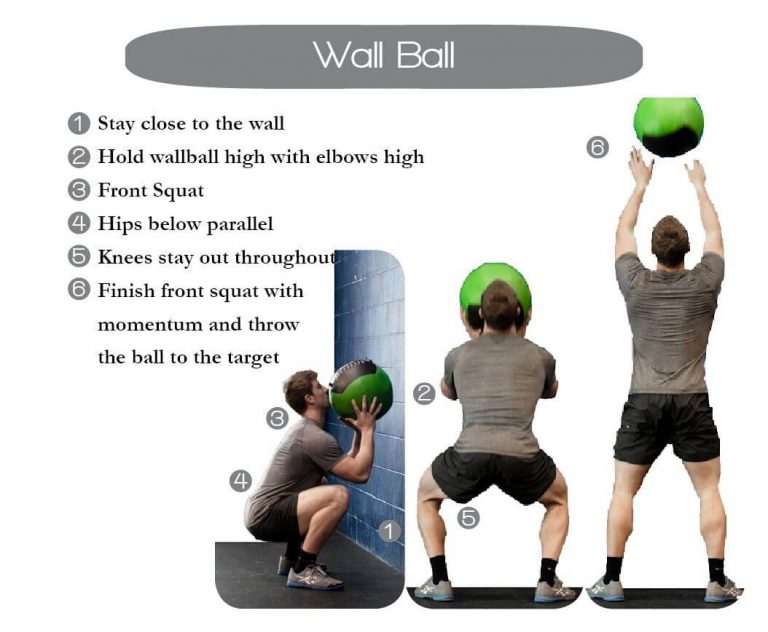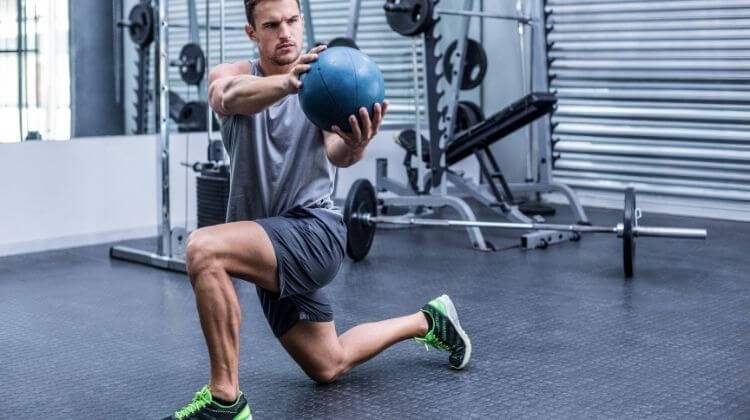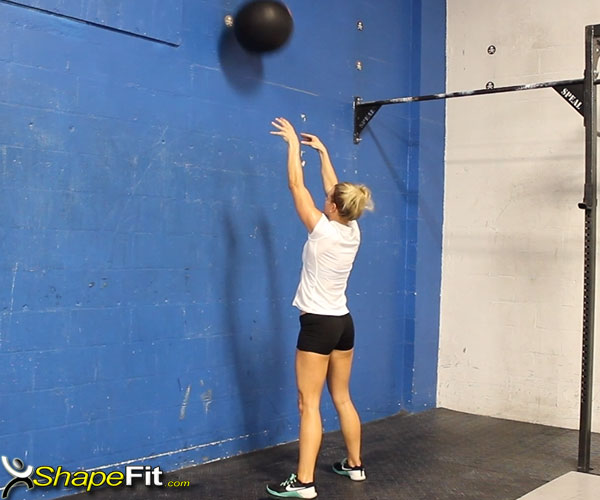What are Wall Ball Workouts?
Wall ball workouts are dynamic, full-body exercises that involve throwing and catching a medicine ball against a wall. These workouts are highly versatile, offering a wide range of benefits for overall fitness. By incorporating wall ball workouts into a regular exercise routine, individuals can improve their cardiovascular health, muscular strength, and flexibility. Wall ball workouts target various muscle groups, including the legs, core, arms, and shoulders, providing a well-rounded fitness experience.
Selecting the Right Equipment for Wall Ball Workouts
Choosing the appropriate equipment is crucial for maximizing the benefits and safety of wall ball workouts. The primary piece of equipment required for these workouts is a wall ball, which is a weighted ball with a diameter of approximately 14 inches. When selecting a wall ball, consider the following factors:
- Weight: Choose a weight that allows for proper form and technique while still providing a challenging workout. For most individuals, a wall ball weighing between 10 and 20 pounds is suitable. Start with a lighter weight and gradually increase as strength and endurance improve.
- Size: Select a wall ball with a diameter that is comfortable to grip and easy to handle. Most wall balls have a diameter of around 14 inches, which is ideal for most users.
- Material: Opt for a wall ball made of durable materials, such as rubber or synthetic leather, to ensure longevity and consistent performance.
In addition to a wall ball, consider using a sturdy wall or solid structure for throwing and catching the ball. A marked wall or designated area can help maintain proper form and technique during workouts. Always ensure that the chosen surface is safe and free from potential hazards, such as sharp objects or slippery substances.
How to Perform Wall Ball Workouts: Techniques and Form
Proper techniques and form are essential for performing wall ball workouts safely and effectively. Follow these step-by-step instructions to master the basic wall ball exercise:
- Stand with your feet shoulder-width apart, facing a solid wall or designated area. Hold the wall ball with both hands at chest level, elbows bent and tucked close to your body.
- Engage your core and lower body, then explosively extend your hips, knees, and ankles to jump. As you jump, throw the wall ball upward, aiming for a target on the wall approximately 8 to 10 feet above the ground.
- As the wall ball descends, track its path with your eyes and prepare to catch it with both hands. Bend your knees and hips to absorb the impact, returning to the starting position.
- Immediately transition into the next repetition by throwing the wall ball back up to the target as soon as you catch it.
To enhance your understanding of the proper techniques and form, consider using visual aids, such as instructional videos or images. These resources can help you identify common mistakes and ensure that you are performing the exercise correctly.
When executing wall ball workouts, focus on maintaining proper form and technique, even if it means using a lighter weight or performing fewer repetitions. Over time, as your strength and skill improve, gradually increase the weight, repetitions, or sets to continue challenging your body and progressing in your fitness journey.
Designing a Wall Ball Workout Routine
Creating a well-rounded wall ball workout routine can help maximize the benefits of this versatile exercise. Consider the following elements when designing your routine:
- Warm-up: Begin with a 5- to 10-minute warm-up to prepare your body for the workout. Engage in light cardio activities, such as jogging, jumping jacks, or cycling, to increase your heart rate and blood flow. Follow this with dynamic stretches, focusing on the muscle groups you will be targeting during the wall ball workout.
- Exercise selection: Choose a variety of wall ball exercises to challenge different muscle groups and movement patterns. Examples include squats, lunges, presses, and twists. Incorporate exercises that target the legs, core, arms, and shoulders, ensuring a balanced and comprehensive workout.
- Sets and repetitions: Determine the appropriate number of sets and repetitions based on your fitness level and goals. For strength and power development, aim for 3 to 5 sets of 6 to 12 repetitions. For endurance, consider 2 to 3 sets of 12 to 20 repetitions. Adjust the weight, sets, and repetitions as needed to maintain proper form and technique throughout the workout.
- Rest periods: Allow adequate rest between sets to recover and maintain the quality of your exercises. For strength and power development, rest for 1 to 2 minutes between sets. For endurance, rest for 30 seconds to 1 minute. Adjust the rest periods based on your fitness level and the demands of the workout.
- Cool-down: Finish your routine with a 5- to 10-minute cool-down to help your body recover and reduce the risk of injury. Perform static stretches, focusing on the muscle groups you targeted during the workout. Hold each stretch for 20 to 30 seconds, breathing deeply and allowing your muscles to relax.
Remember to vary your exercises, sets, and repetitions regularly to keep your body challenged and avoid plateaus. Monitor your progress and adjust your routine as needed to ensure continued growth and development in your wall ball workouts.
Incorporating Wall Ball Workouts into Your Fitness Regimen
Integrating wall ball workouts into your existing fitness routine can provide a fresh challenge and enhance your overall fitness level. Consider the following suggestions when incorporating wall ball workouts:
- Workout frequency: Include wall ball workouts in your routine 1 to 3 times per week, allowing adequate recovery time between sessions. This frequency ensures that you can maintain the quality of your exercises while still challenging your body.
- Duration: Allocate 20 to 30 minutes per workout session for wall ball exercises. This duration allows for a comprehensive and effective workout while still leaving time for other exercises or activities in your routine.
- Intensity: Adjust the intensity of your wall ball workouts based on your fitness level and goals. For strength and power development, focus on using heavier weights and performing fewer repetitions. For endurance, use lighter weights and perform more repetitions. Always prioritize proper form and technique over intensity to avoid injury.
- Progression: Gradually increase the difficulty of your wall ball workouts over time to continue challenging your body and promoting growth. This progression can be achieved by increasing the weight, repetitions, sets, or exercise complexity. Monitor your progress and adjust your routine as needed to maintain a consistent level of challenge.
By incorporating wall ball workouts into your fitness regimen, you can enjoy a diverse, engaging, and effective exercise experience that targets various muscle groups and contributes to your overall fitness goals.
Combining Wall Ball Workouts with Other Exercises
Integrating wall ball workouts with other exercises can provide a comprehensive and balanced fitness routine, maximizing the benefits of each exercise modality. Here are some examples of complementary exercises and routines:
- Strength training: Combine wall ball workouts with traditional strength training exercises, such as deadlifts, squats, and bench presses. This combination targets various muscle groups, improving overall strength and muscular development. For example, perform a wall ball squat throw followed by a barbell deadlift, allowing for a seamless transition between exercises.
- Cardio workouts: Incorporate wall ball exercises into your cardio routine to create a high-intensity interval training (HIIT) session. For instance, alternate between 30-second wall ball exercises and 30-second rest periods, repeating for 15 to 20 minutes. This approach not only enhances cardiovascular fitness but also adds variety to your workout regimen.
- Flexibility and mobility exercises: Pair wall ball workouts with stretching and mobility exercises to improve overall flexibility and joint health. For example, perform a wall ball lunge matrix, followed by dynamic stretches targeting the hips, hamstrings, and glutes. This combination helps maintain proper form and technique during wall ball exercises while reducing the risk of injury.
By combining wall ball workouts with other exercises, you can create a diverse, engaging, and well-rounded fitness routine that targets various aspects of physical fitness. Always prioritize proper form and technique, allowing for a safe and effective workout experience.
Tracking Progress and Setting Goals in Wall Ball Workouts
Tracking progress and setting goals in wall ball workouts is essential for long-term success and continuous improvement. By monitoring your performance and setting achievable goals, you can maintain motivation, enhance self-awareness, and ensure that your workout routine remains engaging and effective. Here are some tips and suggestions for tracking progress and setting goals in wall ball workouts:
- Consistency: Establish a consistent workout schedule, allowing for accurate progress tracking and goal setting. Aim to perform wall ball workouts on a regular basis, ideally 1 to 3 times per week, depending on your overall fitness regimen.
- Patience: Understand that progress may take time and may not always be linear. Be patient with yourself and recognize that small improvements can lead to significant gains over time.
- Self-motivation: Cultivate a sense of self-motivation, focusing on the intrinsic rewards of exercise, such as improved health, well-being, and personal growth. Set goals that align with your values and interests, ensuring that your workout routine remains enjoyable and fulfilling.
- Tracking tools: Utilize fitness apps, workout journals, or other tracking tools to monitor your progress. Record the weight, repetitions, sets, and rest periods for each wall ball exercise, allowing for a clear visualization of your development over time.
- Goal setting: Set SMART (Specific, Measurable, Achievable, Relevant, Time-bound) goals for your wall ball workouts. For example, aim to increase the weight or repetitions for a specific exercise by a certain date or improve your overall workout duration by a specific percentage within a given timeframe.
- Progressive overload: Implement progressive overload strategies, such as increasing weight, repetitions, sets, or exercise complexity, to continually challenge your body and promote growth. Regularly reassess your goals and adjust your workout routine as needed to ensure continued progress.
By tracking progress and setting goals in wall ball workouts, you can optimize your fitness journey, fostering a sense of accomplishment, motivation, and personal growth.
Staying Motivated and Overcoming Challenges in Wall Ball Workouts
Staying motivated and overcoming challenges are essential aspects of any fitness journey, including wall ball workouts. By adopting a growth mindset and practicing self-compassion, you can navigate setbacks and maintain a positive, resilient attitude. Here are some strategies for staying motivated and overcoming challenges in wall ball workouts:
- Set realistic goals: Establish achievable goals for your wall ball workouts, considering your current fitness level, available time, and resources. Break larger goals into smaller, manageable milestones, allowing for a sense of accomplishment and progress.
- Embrace a growth mindset: Recognize that challenges and setbacks are opportunities for growth and learning. Embrace the process of improvement, understanding that setbacks are temporary and that persistence and dedication will lead to progress.
- Practice self-compassion: Treat yourself with kindness and understanding, acknowledging that everyone experiences setbacks and challenges. Avoid self-criticism and focus on the progress you have made, rather than fixating on perceived shortcomings or failures.
- Find a workout buddy: Exercising with a friend or family member can provide motivation, accountability, and support. Share your goals and challenges with your workout buddy, and work together to overcome obstacles and celebrate successes.
- Mix it up: Incorporate variety into your wall ball workouts, experimenting with different exercises, sets, and rep schemes. This approach not only keeps your workouts engaging but also ensures that you are targeting various muscle groups and fitness components.
- Seek professional guidance: Consult with a fitness professional, such as a personal trainer or coach, for personalized advice, support, and motivation. A fitness professional can help you design a safe, effective workout routine and provide guidance on overcoming challenges and setbacks.
- Celebrate successes: Acknowledge and celebrate your achievements, no matter how small. Recognizing your progress can boost motivation, self-confidence, and overall satisfaction with your fitness journey.
By adopting these strategies, you can maintain motivation, overcome challenges, and continue to progress in your wall ball workouts, fostering a positive, fulfilling fitness experience.








